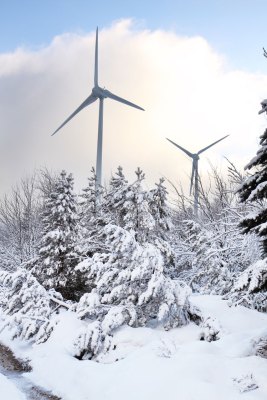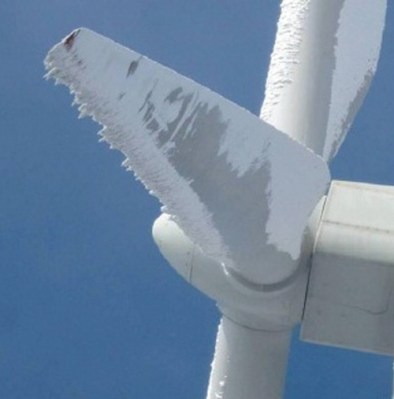Wind Turbines and Ice: How They’re Tailored for Specific Climates
Wind turbines are incredible pieces of technology, able to harvest wind energy and deliver it to the power grid without carbon emissions. Their constant development since the first one came online in 1939 mean that the number of megawatts produced per turbine continues to rise as price per megawatt-hour of wind energy continues to fall. Additionally, they can operate in almost any climate to reliably generate energy almost anywhere in the world from Canada to the North Atlantic to parts beyond. While the cold snap that plowed through the American South recently might seem to contradict this fact, in reality the loss of wind power during this weather event is partially a result of tradeoffs made during the design of these specific wind farms (and, of course, the specifics of how Texas operates its power grid, but that’s outside the scope of this article) rather than a failure of the technology itself.

First, building wind turbines on the scale of megawatts isn’t a one-size-fits-all solution. Purchasing a large turbine from a company like GE, Siemens, or Vestas is a lot like buying a car. A make and model are selected first, and then options are selected for these base models. For example, low but consistent wind speeds demand a larger blade that will rotate at a lower speed whereas areas with higher average wind speeds may be able to get by with smaller and less expensive blades for the same amount of energy production. Another common option for turbines is cold weather packages, which include things like heaters for the control systems, hydraulics, and power electronics, additional insulation in certain areas, and de-icing solutions especially for the turbine blades.
In a location like Texas that rarely sees cold temperatures for very long, it’s understandable that the cold weather packages might be omitted to save money during construction (although some smaller heaters are often included in critical areas to reduce condensation or humidity) but also to save on maintenance as well: every part in a wind turbine has to be maintained. Continuing the car analogy, it’s comparable to someone purchasing a vehicle in a cold climate that didn’t come equipped with air conditioning to save money up front, but also to avoid repair costs when the air conditioning eventually breaks. However, there are other side effects beyond cost to be considered when installing equipment that’s designed to improve a turbine’s operation in cold weather.
Let’s dig into the specifics of how wind turbine equipment is selected for a given wind farm.
Good Design Involves Tradeoffs
Improving a turbine’s ability to operate in cold weather may actually decrease its ability to operate in hot weather, which Texas at least is guaranteed to see during large portions of the year. Everything in a turbine generates heat when operating, from the blade pitching equipment to the gearbox and generator to the power electronics which tie them electrically to the grid. Expelling the waste heat in summer is much more important in these places than preparing them for a few days of cold weather that might not even happen in any given year. Typically this waste heat is expelled by means of radiators and cooling fans, whether they are installed on the gearbox, generator, power converter, or other heat-sensitive equipment, and the settings at which the cooling systems activate (if they exist at all) may not be easy or possible to change.
This brings up another consideration with wind energy in Texas specifically. Wind is plentiful in Texas, so it was among the first places in the US to adopt early versions of grid-scale wind turbines, some of which are still in operation. These turbines are much less configurable than modern versions, and it may not be easy or possible to change the various temperature settings in a turbine. That means that in some cases, cooling fans are active all the time, or the turbines are otherwise permanently configured in a way that makes them ideal for use in hot climates but quickly trip offline in cold weather. Even modern turbines will go offline if the internal temperatures reach a set point well below freezing (typically -30 °C/-22 °F) in order to prevent damage (note that if grid operators are aware of the weather they’ll be able to predict the loss of generation and plan for it), but if cooling systems aren’t configured for the cold, vents are still open, or insulation is lacking, these turbines will not be immune to the effects of the cold either.
Fighiting Ice: Electric Heat and Special Paint; But Not Helicopters
Other aspects of wind turbines that impact their abilities to operate in extreme cold is how they deal with ice, specifically on the turbine blades. Carbon-based electrical heaters on the blades are common way to control ice buildup. 2014 images of the helicopter deicing tests in Sweden shown in the video below went viral during the Texas outage, but this technique is not used in Texas and doesn’t seem to have seen much adoption anywhere due to the expenses involved. (Also considering the need to have a pilot and at least two other workers on-site during icy conditions.) Installing blade heaters caries its own cost and, at least for the time being, may only make economic sense in areas that are expected to deal with cold during a significant portion of the year.
Other options include using thermal cameras to sense ice buildup and shut the turbine down if the ice becomes severe. While all of these methods so far require energy inputs in order to de-ice blades, an innovative product from a wind turbine company called Gamesa is producing paint that naturally prevents ice formation, eliminating the need for expensive energy-intensive deicing solutions.
Another example of a company using paint to try to prevent ice buildup on blades is at a wind farm in Canada where the site has painted some blades black in order to increase the amount of UV light absorbed from the sun, hoping to naturally increase the temperature of the blades without any novel technology or energy-intensive solutions. While this method is not as widespread as other methods, it demonstrates an example of a tradeoff between hot and cold climates: painting blades black in Texas, while there is some evidence that it may reduce bird fatalities, presumably would have major downsides when the long summers rolled around and the blades heated up beyond design tolerances.
Human Resources in Cold Weather
While all of these technological solutions to extreme climates are the subject of any news cycle focused on the downsides of wind energy, one of the most important things about the operation of wind turbines is often glossed over when considering operation outside of their intended climate: the people who maintain them have to also be prepared to live and work in that climate as well. If a turbine trips offline for a routine reason during a snow or ice event, most wind technicians at sites in places like Texas don’t have access to snowplows, snowblowers, or snowmobiles to access the turbines like they might if they were working in northern Quebec. They may not live in areas that regularly plow or salt the roads, making it difficult or unsafe to get to the site or turbines at all. Even if the technicians are doing something simple to improve the turbine’s performance in cold weather, like shutting hatch vents or adding insulation, they still need to get to the turbines.

Further, there are some safety issues with ice buildup on turbines as well, namely that it has to go somewhere when it falls off of the turbines. For that reason, most technicians have strict rules on approaching turbines during ice events to prevent any ice from shedding off of the turbine and onto them or their vehicles. In a cold climate that has de-icing systems, however, this issue can be more controlled and predictable, but in a place like Texas this means that an otherwise fixable turbine might be left offline for a much longer time while technicians wait for safer conditions.
In conclusion, we’d like to note that the recent disaster in Texas was not related to any fundamentals of wind energy itself, but rather to other issues with their isolated power grid and the trend of American infrastructure to be in a general state of disrepair. Wind turbines are perfectly capable of producing energy in some of the most extreme cold environments on the planet, provided they (and their operators) are designed and equipped to handle the climate. In fact, since air density is inversely proportional to temperature, turbines in cold climates can produce more energy for a given wind speed than those in hot climates. We should also give Texas a pat on the back for investing so heavily in wind energy. As of 2019 the state had just shy of 25 GW of wind power capacity, the most by far of any other state, and installed capacity continues to rise rapidly. They have an incredible amount of wind energy available and they have not let it go to waste. But winterizing turbines in hot climates, especially older turbines that aren’t as configurable, is often infeasible both from an economic point-of-view and also because the process of designing any product, whether it’s a small toy or a giant wind farm, requires tradeoffs.
Post a Comment